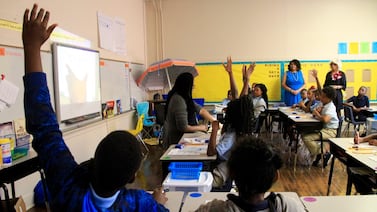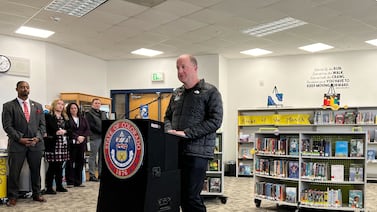Sign up for Chalkbeat Chicago’s free daily newsletter to keep up with the latest news on Chicago Public Schools.
Chicago Public Schools watchdog agency is pressing for changes to how the district collects and uses family income information after finding “scores of employees” abused or mishandled the process — issues the agency has repeatedly called out in the past.
In its annual report for the 2024 fiscal year, the district’s Office of Inspector General found that hundreds of CPS employees appear to have significantly understated their incomes on forms used to determine hundreds of dollars in fee waivers for students and additional funding for campuses serving many low-income students.
The office also investigated a school where clerks mislabeled income information for at least 90 students, resulting in an influx of unwarranted additional funding for that campus.
Families of CPS students share information about household size and income on the paper forms, which once determined whether students qualified for free or reduced-price lunch. Since 2015, all CPS students receive free meals, but the form still carries high stakes for both families and schools.
And yet, the district makes no attempt to verify the numbers families report, and no one is responsible for ensuring information from the paper forms is accurately entered in the district’s systems, the district’s watchdog said. Unlike other large districts, CPS offers no options to fill out the form online.
The watchdog is urging the district to take action. It wants CPS to make the form optional and available online, audit information provided in a random sample of forms, and stop basing a portion of school funding on that information. Families caught providing false income information should be barred from ever receiving CPS fee waivers, the office said.
CPS said in a statement that it formed a committee this fall working to “enhance transparency, accountability, and equity in the student fee processes, including the waiver process,” with new guidelines to be rolled out in 2025-26. The district told the OIG it would also reconsider the role self-reported family income information plays in its new formula aimed at steering more money to higher-need schools.
“The district is taking this very seriously,” said Phil Wagenknecht, the deputy of the OIG’s General Investigations Unit. “But a lot of the potential changes are to be determined.”
The investigation comes as CPS has seen its portion of low-income students decrease amid demographic shifts and gentrification in some neighborhoods. The 12 percentage point decrease over the past decade has affected how much state and federal funding the district receives. Some people suggested the drop was partly due to families no longer filling out the income forms because they are not tied to receiving free or reduced-price meals any more. In any case, the district watchdog noted, weeding out misuse is all the more important as CPS enters leaner financial times.
CPS staffers misreported incomes
In its report, the inspector general’s office noted that during some 15 years of monitoring this issue, it has repeatedly found instances when the district’s Family Income Information Form has been misused.
So last fiscal year, Wagenknecht said, “We decided to take a proactive look at the way these forms are handled by the district.”
For families, information provided through the form can decide whether or not they have to pay a slew of fees — to participate in school activities and sports, use school technology, and apply to college. Officials at one CPS selective enrollment high school told investigators that dozens of parents reach out every winter asking to revise their forms after realizing that reporting a lower income could make them eligible for college application fee waivers.
The OIG notes in its report that its staff doesn’t have access to income information for most families. But they scrutinized numbers provided by the 880 CPS employees who have children designated as low-income in the district — and whose salaries are publicly available. The watchdog’s analysis questioned whether children of about 70% of these district staffers were accurately categorized as low-income. Those included more than 130 employees who make more than $100,000 a year.
The agency acknowledged that in some cases, the designations might turn out to be correct, such as when the students are foster children, who automatically qualify for that low-income status. On the other hand, factoring in spouse incomes, which the OIG didn’t do, could put into question the low-income designations of even more students.
The district doesn’t verify the income families report by asking for pay stubs or tax forms, the OIG noted. Unlike other large districts, CPS offers no options to fill out the form online.
Information from these forms also determines how much money the district steers to schools. It affects federal Title I funding, for schools serving a high percentage of low-income students, as well as some state funding to campuses.
And under a new budgeting model CPS unveiled last year, the portion of low-income students is one factor that goes into calculating the district’s Opportunity Index. That index — a measure of the level of student need at each school — determines whether schools receive funding for smaller class sizes, additional counselors, and more. In its statement, the district noted that because low-income status is just one of roughly a dozen metrics used to calculate the index, the formula has actually reduced its reliance on the forms to set school funding.
The portion of low-income students also factors into the district’s Equity Index, used in deciding which schools to prioritize for building repairs and projects.
The district’s watchdog investigated one school where two clerks entered information from the income forms into the district’s system — and designated dozens of students as low-income in 2018-19 and 2019-20 even though they did not qualify. They included two from a family of four with a reported household income of $330,000. As is customary in its reports, the OIG did not identify the campus or the employees. Both clerks were also the subject of a separate investigation into payroll fraud and theft, and were placed on the district’s “do not hire” list after resigning.
The inspector general did not find evidence that any of the families were aware of the improper designations. The clerks insisted that they simply made a lot of mistakes entering the data. The watchdog could not prove that the errors were part of an intentional effort to secure more funding for the school though it said the evidence is “suggestive” of that. The OIG estimated the school might have received up to $135,000 in unwarranted funding over those two years.
About a quarter of CPS’ low-income students are identified using the family income forms, with the remaining identified using their families’ participation in the food stamps and other welfare programs. Instead of the forms, the district could rely on U.S. Census information for neighborhoods in determining the level of need on various campuses, the OIG suggested.
The report says the district hasn’t decided yet if the forms will continue to be required and available only in paper form next school year. CPS said in its statement that its new student fee committee will come up with standard procedures for changing and waiving fees. If it develops a new family income form, that form will ask whether CPS employees reside in the household.
“CPS will continue to review District policies and procedures to safeguard students, staff members, and the District as a whole,” the statement said.
Other significant findings of the latest OIG report include:
- The basketball coach at one high school recruited at least 17 players who live outside the city or outside the school’s enrollment boundaries and helped them falsify paperwork to evade the district’s residency requirements. The report doesn’t identify the school, but news reports have indicated it’s Kenwood Academy.
- The watchdog has continued to uncover cases of district employees who fraudulently collected money through the federal Paycheck Protection Program, a pandemic relief initiative to help small businesses. Those included one school administrator with a salary of more than $120,000 who got a $20,000 forgivable loan by falsely claiming lost self-employment income.
- The OIG revisited automatic enrollment into the Junior Reserve Officers’ Training Corps (JROTC) program at some high schools, a practice the district vowed to curb after reporting by Chalkbeat and a resulting OIG investigation. The office found that in at least one high school, a high portion of freshmen continue to be steered into the program.
- The portion of laptops, tablets, and other devices reported as lost or stolen has decreased since the OIG and a Chalkbeat/WBEZ report highlighted the issue, and the district has started tracking down some devices by sending recovery messages.
Mila Koumpilova is Chalkbeat Chicago’s senior reporter covering Chicago Public Schools. Contact Mila at mkoumpilova@chalkbeat.org.






